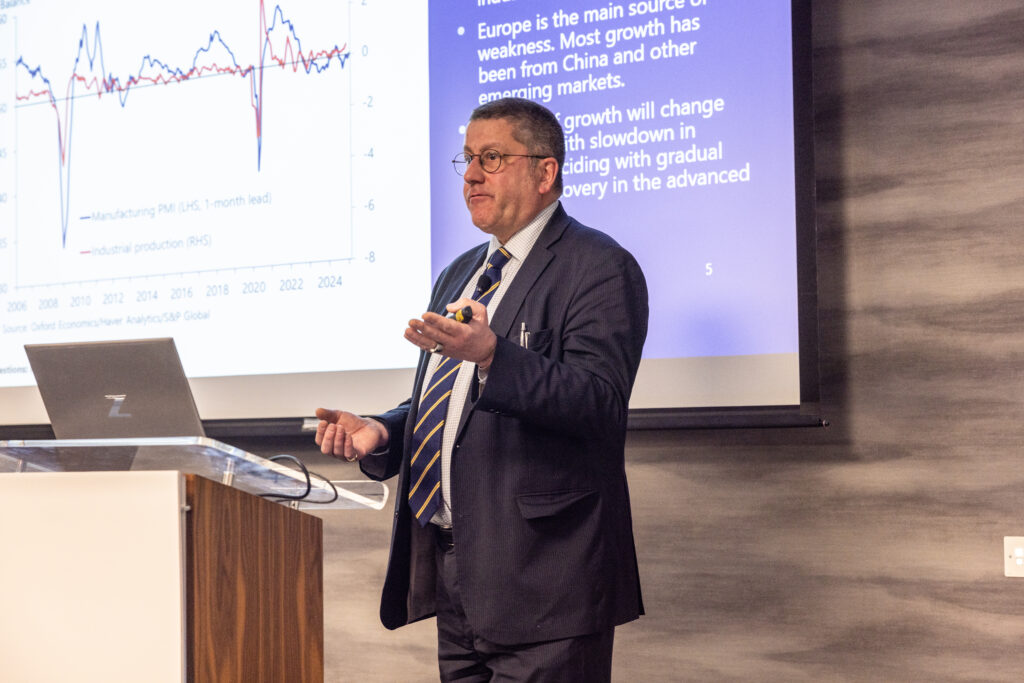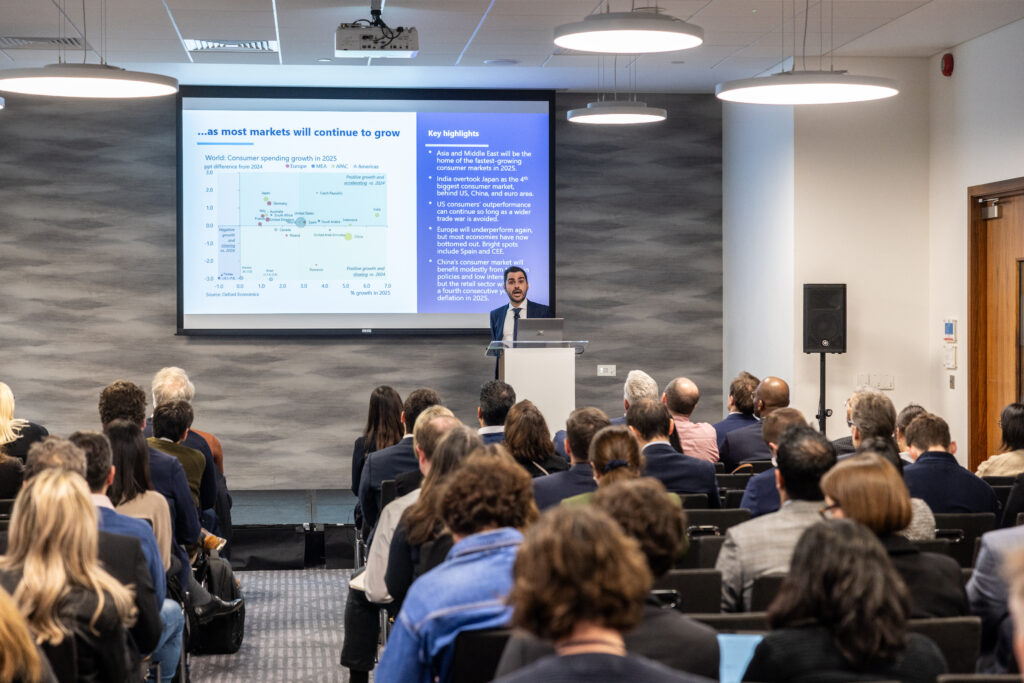Blog | 28 Feb 2025
Steady, Yet Slow: How Oxford Economics Sees Global Economic Growth in 2025

The global economy is set to continue its steady, albeit slow, growth throughout 2025, despite the impacts of tariffs and other socio-economic challenges. This was the key message delivered by Oxford Economics’ Chief Executive Officer, Adrian Cooper, at the firm’s flagship Global Economic Outlook Conference held in London on 5 February.
Over 360 professionals from diverse industries—including finance, mining, technology, and media—participated in the event. Attendees received an in-depth analysis of macroeconomic and microeconomic factors shaping the current global economic landscape, along with insights into their impact across various industries worldwide.
Global Growth Stable, But Challenges Loom
The event began with a review of local and international economic outlooks, followed by breakout sessions that explored the outlook for equity markets, investment strategies, the impact of artificial intelligence, tariffs, industrial sector impacts, and real estate market shifts influenced by interest rate fluctuations. In his opening remarks, Cooper noted that global GDP has been stuck in a sub-par rut, growing by 2.75% in both 2023 and 2024, with similar expectations for 2025.
“While overall global growth has been stable, it is well below the 3 to 3.5% we used to think of as normal for world economic growth,” Cooper said. “That reflects a range of structural challenges, like deteriorating demographics, poor productivity growth, the broken Chinese growth model, and the end of increasing globalisation.” President Donald Trump’s recent announcements have also called into question the stability we expect in global economic growth moving forward, Cooper noted.
“As international trade stability is called into question, we see three major concerns: The impact of tariffs particularly at a sector and sub-national level; the impact of President Trump’s broader policy program, including migration and fiscal measures, on U.S. economic exceptionalism relative to China’s economic slowdown and Europe’s stagnation; and the long-term effects of deglobalisation and demographic shifts.”

US: Productivity Boosts Resiliency
Despite these challenges, the United States is expected to retain its so-called “exceptionalism” that puts its economy far ahead of the rest, largely thanks to its productivity, driven by strong investment in new technologies, and robust household consumption. This was highlighted by Innes McFee, Chief Global Economist at Oxford Economics and one of the key presenters at the event. For McFee, the impact of Trump’s tariffs would have negative effects on the US economy, but it could eventually be mitigated by fiscal measures.
“Consumer spending, however, is being increasingly driven by those at the top end of the distribution while low-income households struggle with the increased cost of living. Tariffs on food and energy products would exacerbate these trends,” McFee noted.
Speaking of the US, Cooper called attention to the “inherent contradiction between immigration policy and manufacturing policy” being developed by Trump, as it seeks to boost domestic industry but restricts the immigrant labour needed to carry it out. “That may also make the U.S. a less attractive place to invest by increasing labour costs,” Cooper said.

Europe: Spain, Portugal Shine
In Europe, Manufacturing regions such as Germany will face stagnation, McFee said, while those countries leveraged by tourism and services, such as Spain and Portugal, will grow.
Analysts envision 1.1% growth for the European bloc. However, if Trump decides to continue imposing tariffs on the European Union to balance his country’s trade deficit, that percentage would drop to 0.9%. The European industrial sector has been hit particularly hard by the energy crisis stemming from the Russian invasion of Ukraine, added Jeremy Leonard, Managing Director of Global Industry Services and a presenter at the event. But the key factors that drove Europe into recession – high energy prices and high interest rates – have reversed, and this will lay the groundwork for a cyclical recovery, albeit fairly shallow. Even by the end of 2025, the advanced economies will only be in the beginning phases of a cyclical recovery, he added.


China faces industrial slowdown
China, on the other hand, is facing an industrial growth slowdown, Leonard said in his presentation. Part of this is due to the impact of the 10% across-the-board tariffs already put in place by the Trump administration, but a bigger factor is the inability of the construction and heavy industrial sectors to generate the kind of growth that it has done in the past. The result, he added, is that the mix of growth this year will shift in favour of the developed economies, but China’s challenges and the risks of trade war escalation put limits on the growth potential of the industrial side of the economy.
Consumer outlook upbeat, spending accelerates slightly
The global consumer outlook for 2025 remains relatively upbeat, but consumer spending will only accelerate slightly in 2025, said Marcos Casarin, Corporate Advisory Engagement Lead at his presentation. “We see robust performance in the US, but continued challenges to consumer spending growth in Europe and China,” he said.
In the case of China, most of the opportunities will be in categories covered by the government’s trade-in policies, while European demand will be stronger in Eastern and Southern Europe in particular. While labour markets remain relatively resilient and wage growth will be positive in many key consumer markets, the previous several years of high inflation may lead to some lingering consumer hesitation, particularly in Europe, Casarin noted.
“As interest rates come down, we expect a gradual pickup in demand for durables, but the process may be relatively slow. Meanwhile, Chinese consumers will continue to adjust to the drop in property market values and a more challenging growth outlook, prioritising savings over spending and exhibiting strong price sensitivity.”
Among emerging markets, we see considerable opportunities, Casarin stated.
“We expect the emerging markets middle class to double in size in the next decade, with growth particularly strong in India and Southeast Asia. In the next five years, China and India will create 113 million new middle-class households, while another 30 emerging markets will add 53 million additional households to the emerging markets middle class,” he said.
Risk is palpable, but opportunities for those who adapt
There exist a wide range of risks to long term global growth which makes scenario analysis a valuable tool, said Felicity Hannon, Director, Modelling and Scenarios, during her “Looking Long Term” presentation at the conference. “There is considerable uncertainty about trade policy and AI presents an upside risk,” she added.
“Fragmentation of global trade and the rise of populism could lead to higher public debt and harm real incomes and profitability.” This is reflected in the global GDP numbers as the aggregate economy suffers,” Hannon said. “The average long-run growth rate for this scenario is 1.3%, almost 0.8% lower than in our base case.”
Yet advancements in technology, strengthened trade relations, and a growing labour force could collectively boost global economic growth prospects, she noted. “These elements drive productivity, stimulate innovation, and contribute to a more interconnected and dynamic global market allowing EMs to catch up,” Hannon added. The long-run growth rate for this scenario is more than 3% on average, she stated, almost 1ppt higher than in the baseline.

Understanding the shape of a new reality
Insights from the Global Economic Outlook Conference underscored the critical role of technological innovation, shifting trade policies, and demographic trends in shaping the future economic landscape. While risks such as tariffs, deglobalisation, and policy uncertainties persist, opportunities remain for those who adapt strategically.
Oxford Economics remains committed to providing data-driven analysis and expert guidance to help leaders make informed decisions in an increasingly complex world. Stay ahead with ongoing insights into key trends and emerging topics shaping global growth opportunities in a challenging economic landscape. Subscribe to our newsletter today.


Author

Innes McFee
CEO

Innes McFee
CEO
London, United Kingdom
Innes McFee is the Chief Executive Officer and Chief Economist of Oxford Economics, based in London. Innes is responsible for coordinating and managing Oxford Economics’ global economic analysis, forecasting and consultancy activities, and overseeing its global team of over 450 professionals including 300 economists and analysts. Innes has worked in the Macroeconomic Consulting and the Macro & Investor Services teams since joining Oxford Economics in 2017. Most recently he has led the growth in Oxford Economics’ subscription business writing and presenting to clients globally on macroeconomic, investment strategy and real estate issues.
Innes joined Oxford Economics after 6 years at Lloyds Banking Group as a Senior Economist, where he was responsible forecasts and analysis of the UK and international economy. Prior to joining Lloyds Innes was an Economic Advisor at HM Treasury. Innes has a first-class undergraduate degree in Economics from the University of Durham and an MSc in Economics from Warwick University.
Tags:
Key Themes for 2025

UK Key Themes 2025: Worrying debt dynamics shift into focus
The UK has several long-running structural problems to solve and there's much the new government needs to do.
Find Out More
Industry Key Themes 2025: Industrial landscape at a critical juncture
Following prolonged weakness in 2022 and 2023, industrial growth is now regaining momentum.
Find Out More
Strategy Key Themes 2025: Opportunities amid heightened uncertainty
We think the environment of strong US demand coupled with still ample global liquidity, should be positive for US risk assets.
Find Out More
Outlook for cities in 2025: Identifying opportunities and risks
On average, cities from across the world, with the exception of China, will see GDP growth either increase or maintain pace in 2025.
Find Out More
Key climate and sustainability themes for 2025
We expect economic growth to remain modest in 2025, although we don’t think a substantial slowdown is on the way either.
Find Out More
Real Estate Key Themes 2025: A tentative revival for CRE growth
After a year of transition in the commercial real estate cycle in 2024, we believe CRE is poised for a tentative revival in values.
Find Out More
Cities Key Themes 2025: Cautious optimism
In 2025, on average we expect cities in most regions, except China, will see GDP growth accelerate or maintain pace.
Find Out More
Tourism Key Themes 2025: Growth continues amid greater uncertainty
Travel demand will continue to grow in 2025, despite heightened uncertainty in key demand drivers and markets.
Find Out More